
Semi-Automatic Keys or "Bugs" ( 1902 - Present )
Semi-Automatic Keys or "Bugs" ( 1902 - Present )
By 1900, telegraph operators were handling tremendous amounts of traffic and there was a need for a way to send Morse Code more rapidly than was possible with a conventional hand key. Horace G. Martin’s 1902 invention of the Semi-Automatic key dramatically increased the message handling capacity of an operator by allowing dots to be made automatically. When his very broadly-written Vibroplex patent ran out in the 1920’s many other manufacturers began making bugs.
Identification of Bugs:
Gil Schlehman, a Chicago collector with the world’s largest bug collection containing over 250 DIFFERENT models of bugs says that there are plenty more out there. This book can’t include all of them but I have included most of the bugs which you are likely to find as well as lists and references that will help identify most of the others.
Please see the bibliography for Bill Holly-K1BH’s excellent Vibroplex Book. Most of these Vibroplex pictures are from his book and used with permission.
John Ellwood has spent many years cataloging the serial numbers of Vibroplex bugs. Information from his list is included in this book and helps to date the keys. The entire list is in Tom French’s excellent book on Vibroplex. Doug Seneker’s List of the Known Bugs also adds a great deal of information.
"Bug" Collectors and "Bug" Values:
Many collectors specialize in Bugs because of their historical importance and mechanical complexity. In general, the OLDER and RARER the bug, the more it is worth although some bugs are worth much more than this formula would suggest. I have tried to explain special bug pricing criteria along with each bug if it does not follow the "OLDER and RARER" guideline.

The Autoplex: ( 1902 )
In 1902, Horace G. Martin patented the first telegraph key capable of making dots automatically. The Autoplex was not very convenient because it required the use of batteries to power its mechanism, but it was the first of a long line of semi-automatic keys designed to increase an operators ability to send fast code. Very rare. [200] (The Gil Schlehman - K9WDY collection.)

The Metal Autoplex: (1904)
In 1904, Horace Martin began manufacture of an all-metal Autoplex. The heavy metal bar running from right to left across the top of the key was made to vibrate and produce dots by the two coils which were energized by batteries. Not very many of these keys were made and they are very hard to find. [202] (The Russ Kleinman WA5Y collection.)
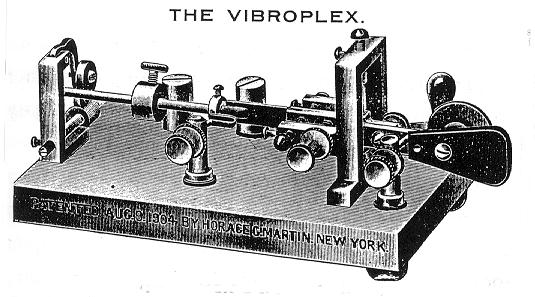
The Vibroplex "Original": ( 1904 - present )
Martin’s next invention was a key that made dots automatically with a totally mechanical vibrating mechanism. Named the "Original", it has remained virtually unchanged to the present. 3-1/2 inch-wide base. Its value depends on its age as shown by its serial number. Earliest: s/n<1K [204]. Recent: s/n>200K [204a] (K1BH picture)
"Deluxe" Model and Colored-Base Vibroplex Keys:
Vibroplex keys were available in "standard" models with black Japanned finish and later (around 1933) wrinkle-finished black. They were also available with Nickel and later Chrome-plated bases and with colored bases. (During the 1950’s some of the chrome finish was particularly susceptible to pitting and 1950’s Vibroplex keys have often been replated.) Deluxe and Colored-Base Vibroplex keys are worth about 20% more than standard models.
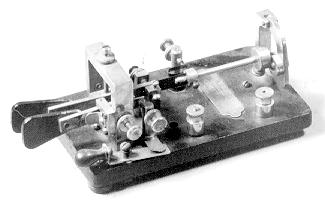
Vibroplex "Double Lever: ( 1907 - 1925 )
This key has separate levers for the dot and dash functions. It has a very light, crisp "feel". 3-1/2 inch wide base. [208] (Bill Holly - K1BH photo.)

Vibroplex Model "X" Square Shaft Model: "Single Lever" also called "Single Contact" and "Single Point" (1911 - 1923 )
This key has an intricate mechanism which allows a single set of contacts to make both the automatic dots and the manual dashes. The first model "X" keys had square vibrating shafts. 3-1/2 inch wide base. [212]
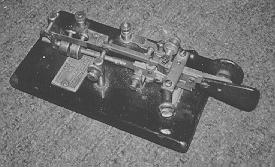
Vibroplex Model "X" Round Shaft, (also called "Improved" Model:)
This key is similar to the square shaft version and uses a single set of contacts for both dots and dashes. The vibrating shaft, however, is round rather than square. [213]
Vibroplex "Pseudo-X": This key is basically a Vibroplex Original but it uses the Round-Shaft Model "X" damper, dot spring, and dot contact. 3-1/2" wide. [214].
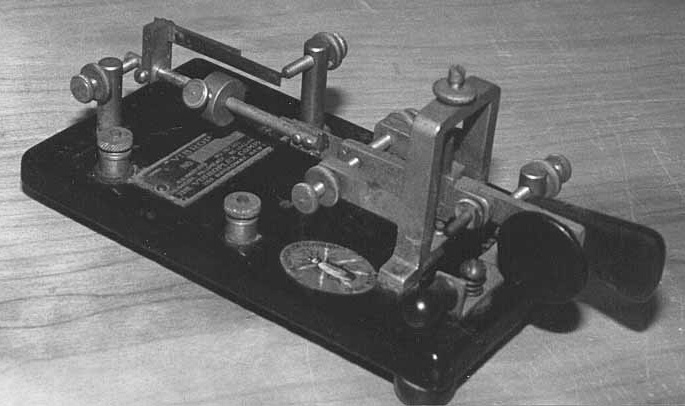
This very rare left-handed example is owned by Ed Biter - NS3E. [215]
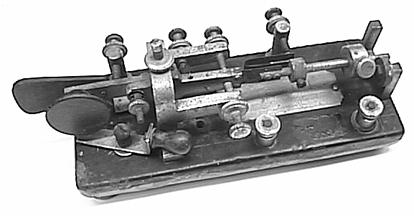
Vibroplex No. "4" - Blue Racer: ( 1914 - 1966 )
This key was designed to be carried easily in a pocket. It is similar in design to the Original but the base is only 2-1/2 inches wide. Early [216] Late [216a]
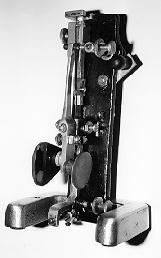
Vibroplex "Vertical", or "Upright", or "Wire Chief’s Key": ( 1917 - 1919 )
Responding to the need for a key that took up very little of the space on top of the table of a busy wire chief, Vibroplex designed a vertically-oriented version of their Model "X". It was nicknamed the "Wire Chief’s Key". Since they are very hard to find, Vibroplex must not have been able to sell very many of them. [220]
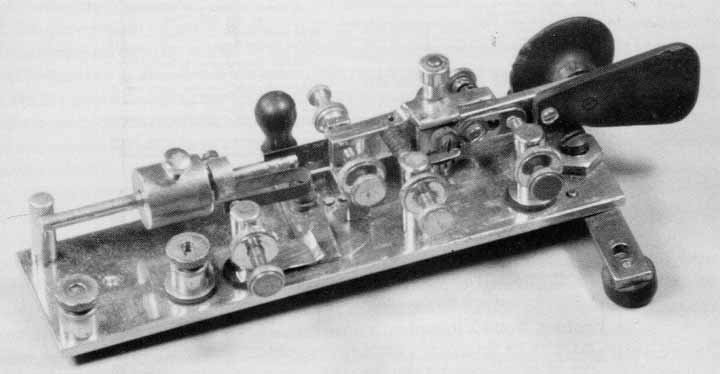
Vibroplex Midget: ( 1918 - 1920 )
There are VERY few examples of this tiny pocket-sized key. It was built on a thin, 1-1/2 inch wide base which required an articulated rear leg for stability. [224] (K1BH photo)

Vibroplex Junior: ( 1920 - 1939 )
This is an intermediate sized key which can be easily identified by it’s 3-inch wide base and "Original" mechanism. It was one of the Vibroplex keys that were made with Blue, Green, Red, and Black colored bases. [226] (K1BH)

Vibroplex No. 6 "Lightning": (1927- 1980 )
This simple key has a flat, calibrated vibrating lever and "M" shaped damper. It has a nice crisp feel and was, and is, very popular. It has a 3-1/2 inch wide base. A version of it called the J-36 was used by the military in WW-II. [228] (K1BH)

Vibroplex J-36 ( 1935 - 1943? )
This is the military J-36 version of the Vibroplex Lightning bug - (see above). It has a 3-1/2 inch wide base. [230] (Bill Holly - K1BH photograph.)

Bunnell J-36: ( 1941 - 1945 )
During WW-II, the J. H. Bunnell Co. manufactured their own version of the J-36 bug. [232]
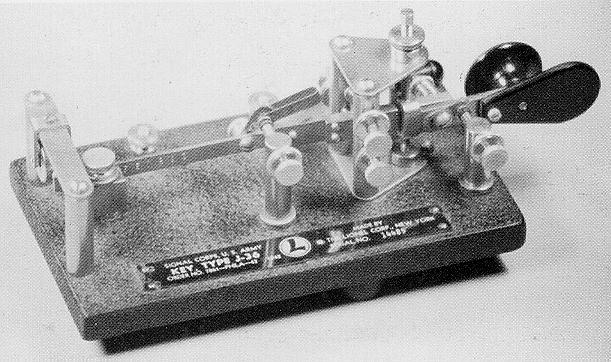
Lionel J-36: ( 1941 - 1945 )
During WW-II, Vibroplex could not keep up with the demand for bugs so The Lionel Electric Co., makers of Lionel Toy Electric Trains manufactured J-36 keys using the Vibroplex Lightning Bug design. [234]

The plastic LIONEL label often curls up in sun and heat. It is shown full-size in the printed book. If yours is missing seal the one in the book in plastic and glue it on your key. You may also download it from http://w1tp.com, print it, seal it, and glue it on your key. [234a]

Vibroplex Champion: ( 1939 - 1980 )
Similar to the Lightning but has a simpler vertical damper. 3-1/2" wide base. (NOTE: This is actually a photo of a Zephyr since it has a shorting lever and Champions do not have one.)[238](K1BH)

Vibroplex Zephyr: (1939 - 1958 )
A Champion on a narrower 3-inch wide base WITH shorting lever.[240] (Bill Holly, K1BH photo.)

Vibroplex Presentation: ( 1948 - present )
This is an Original with a gold-plated plate on the base, all-chrome parts, and bright red trim and finger pieces. [242] (Vibroplex Co. photo)

Vibroplex Vibro-Keyer: ( 1960 - present )
This is the "Classic" single lever paddle. [244] (Vibroplex Co. Photo)

Vibroplex Iambic Keyer: ( 1979 - present )
This is a revised version of #244 designed for use with iambic keyers. [246] (Vibroplex Co. photo)

Vibroplex Brass-Racer Iambic: ( 1982 - present )
This is a brass-based Iambic keyer. The model EE-1 has a built-in electronic keyer chip. It is currently also being produced with a square base. [248] (Vibroplex Co. photo)

Vibroplex Straight Key: (1996 - present )
This is a lovely LARGE, nicely balanced straight key mounted within an original-like frame on heavy base.[250](Vibroplex.Photo)
NOTE: As this book went to press, Vibroplex announced their new BLUE RACER 2000 Which they call their ‘Millenium Bug’.
( For a Current Vibroplex Catalog, see: http://www.vibroplex.com

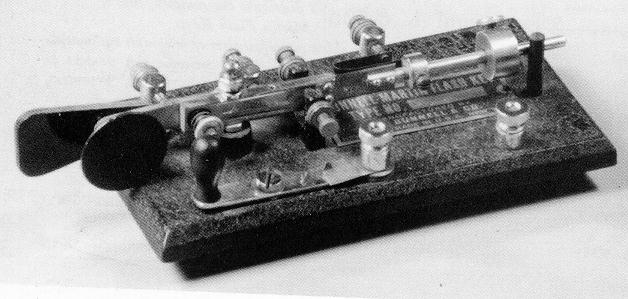
Martin Leaves Vibroplex: The Bunnell-Martin Flash Keys: ( 1930’s )
In the 1930’s Martin left The Vibroplex Co. and began manufacturing a line of narrow-based keys which were called Martin Flash keys and then Bunnell-Martin Flash Keys after Martin sold his interest in them. [252] (K1BH photos)

Mecograph Bugs Which Try to Avoid Martin’s Patent: ( 1906 - 1913 )
Martin’s original patent was so broadly written that it covered just about every conceivable method of automatically making dots. However a clever 1906 patent by Coffee did not infringe on Martin's patent and led to the development of the Coffee Vertical key. This only known example of the priceless key is owned by collector Russ Kleinman - WA5Y. [254]
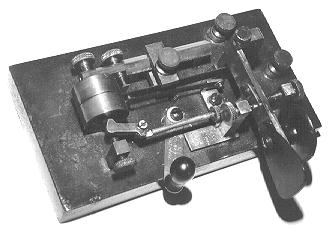
Mecograph Right-Angle and Straight Bugs: ( 1907 - 1913 )
Since Vibroplex dots were made by TENSIONING a spring, in order to avoid infringing on Martin’s patent, Coffee, and then Benjamin Bellows invented a key that made dots by RELEASING tension on a spring. Bellows manufactured these "Mecograph" keys in a right-angle [256] design.

He also manufactured a hard-to-find straight version [258] until Vibroplex bought his company after his death in 1913 and ended production of his keys. (258 is a Bill Holly, K1BH picture)
Patent Infringement From MANY Companies: ( 1912 - 1920’s )
Semi-automatic bugs were so popular that many companies began manufacturing blatant copies of Martin’s patented Vibroplex keys. Some of these companies were: Dunn (Dunnduplex), MacDonald, Mt. Auburn Specialty Co, O. M. Thomas Electric Co., A to Z Electric Novelty Co., etc. J. E. Albright, as Martin’s agent took decisive legal action against all of these companies and put all of them out of business. These "illegal" keys do not have much value to most collectors. [260]
J. E. Albright "Licensed" Bugs / "Legal" Bugs: ( 1912 - 1920’s )
Although the companies that made the Non-Vibroplex keys were forced out of business, many operators continued to use them and Albright convinced the companies that employed these operators that "Vibroplex" keys were the only "Legitimate" bugs. Rather than outlaw the use of all of these bugs, the companies insisted that each one be "inspected" for quality of operation and, if it passed, it could become a "LICENSED BUG" if the owner purchased a license tag from Albright.

The licenses cost $2 and read: THIS MACHINE IS NOT GUARANTEED NOR MADE BUT ONLY LICENSED BY J. E. ALBRIGHT. "Licensed" bugs were nicknamed "The Legal Bug", or "The Albright Bug". [262]
(This photograph and most of the Vibroplex bug photos are used with permission, from Bill Holly’s important and scholarly book on Vibroplex which is out of print.

Bunnell’s "Gold Bug": (1922 - )
As Martin’s patent was running out, Bunnell began producing a very attractive bug which he hoped would attract buyers through it’s appearance. It was made of brass with a gold-plated label and looked extremely impressive. The problem was that it was a TERRIBLE key with a mushy feel and it was so poorly received that only 1200 were made. Many were being given away free with any purchase over $50 by many suppliers. They are now hard to find. [264]
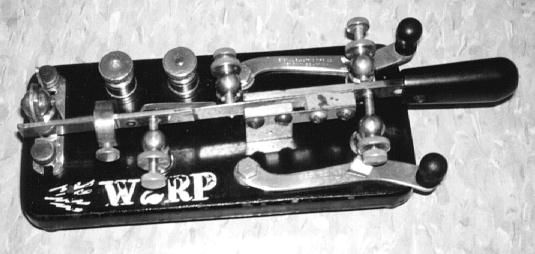
The "Sematic" by Signal Electric Co. ( 1920’s - )
This interesting key combined a very good sideswiper and a bug. It had a clip to secure the vibrating lever when it was being used as a sideswiper, and a circuit-closing lever on each side. [266] (W2PM key)

The "Ultimate" or "73" Bug: ( 1925 - )
This truly pocket-sized right-angle bug with a cover over the mechanism became quite popular during the late 1920’s. Several models were made. Scarce. [268]
The Logan and then Johnson "Speed-X" Bugs: ( 1920’s - )
The Les Logan Company (Later taken over by the E. F. Johnson Co.) made a popular and inexpensive line of bugs.

The Speed-X Model 501
This is the Speed-X "Professional Model" It has a chromium plated steel base and chromium plated brass mechanism with a "T"-shaped frame for easy carrying. [270]
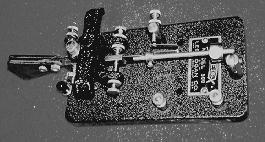
The Speed-X Model 500
This is the Speed-X "Standard Model" It has a black wrinkle baked enamel finish and the "T"-shaped frame.[270a] (Right)

The Speed-X Model 500 (Variant)
This variant had a chromium plated brass "T"-shaped easy-carrying frame on the black wrinkle baked enamel base.[270b]
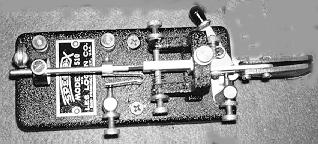
The Speed-X Model 510 (Junior): A pocket - sized ''T - less'' version. [270c]
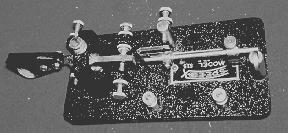
The Speed-X Model 515 Amateur Model: A full size model without the "T"-frame. [270d]


Above are early unlabeled chrome-based versions of the Speed-X keys. [272, 272a]

The "Go-Devil"
Several models of this key were made by A. H. Emery in Poughkeepsie, New York. It is believed that only about 200 of each model were produced. [274]
Theodore McElroy’s Keys: ( 1934 - 1942 )
Theodore McElroy, who held the record as the world’s fastest telegrapher, had copied code at 75.2 words-per-minute during a well attended contest in 1939. He cast his claim to being the "Worlds Fastest Telegrapher" into the base of the earlier models of a line of keys that were interesting and innovative.
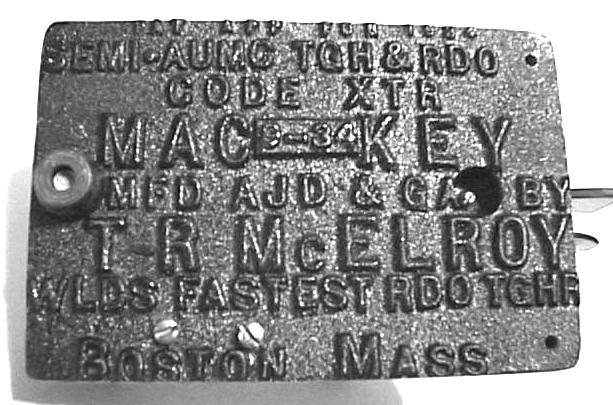
The inscription reads:
(In Telegrapher’s short hand)
PAT APP FOR 1934. SEMI-AUMC TGH & RDO CODE XTR. MAC-KEY. MFD AJD & GA BY T R McELROY. WLDS FASTEST RDO TGHR. BOSTON MASS
(Translation: Patent applied for 1934. Semi-automatic Telegraph and Radio Code Transmitter. Mac-key Manufactured, Adjusted, and Guaranteed by T. R. McElroy. World’s Fastest Radio Telegrapher. Boston, Mass.)
The McElroy "Mac-Keys": ( 1934 - 1942 )
The early Mac Keys were characterized by a "T" shaped frame that allowed them to be laid-over on their left side and used as straight keys. A small clip prevented the lever from vibrating when they were used in this way.
They went through many interesting changes in design as described in Tom French’s Book: "McElroy, World’s Champion Telegrapher". Many of the model changes were not identified as separately-named models and are identified, instead, by their date of manufacture. Most of the following pictures and details about design features are used with permission from Tom French’s book. (See Bibliography.)

The Earliest McElroy Models: ( 1934 and 1935 )
McElroy’s first models have diagonal steel bars that carry the dot and dash contact voltages. In the 1934 model [278] (Not shown), the dot contact was not supported by a casting. It was just located at the end of the diagonal steel bar.
In the 1935 model (shown) [278a], the dot contact was supported by the metal casting. (Tom French - W1IMQ photograph.)

The 1936 McElroy Mac-Keys: (The last models with cast lettering under the base.)
These keys are characterized by an "L"-shaped bar which connects and supports the dot and dash contacts and carries the electrical current from them. There are several minor refinements of this basic design. [278b] (Tom French - W1IMQ photograph.)

The McElroy "Junior": ( 1936 - 1938 )
This key was designed to be a very inexpensive model that anyone could afford to own. Several minor refinements were made in its design as described by Tom French in his book on McElroy. The "Junior" was made of sheet metal and apparently, very few were sold because they are EXTREMELY hard to find. [280]
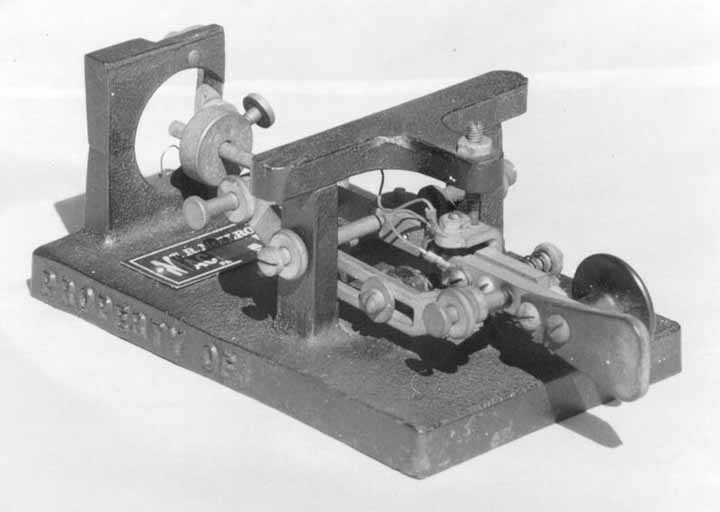
The 1937 McElroy Mac-Keys: (The first models without cast letters under base.)
These keys are characterized by a "U"-shaped bar which connects and supports the dot and dash contacts and carries the electrical current from them. A U.S.Navy model, CMK-26009 [281] (Shown) is hard to find. A civilian model [281a] is more common. (Tom French - W1IMQ photograph.)

The 1938 McElroy Mac-Keys:
Like the 1937 models, these keys also have the "U"-shaped bar which connects and supports the dot and dash contacts and carries the electrical current from them. They also have the larger nameplate. They were available in a "Standard" black wrinkle-finish paint [281b], and in a "Deluxe Marbelite" finish (shown) with larger adjustment screws, a circuit closing switch, and a "dot stabilizing" pre-tensioner clip on the dot spring. The deluxe version with the Marbelite finish (made by spraying a random pattern of white paint to simulate marble) is considered quite attractive and commands a premium price among collectors. [281c] (Tom French photograph & info.)
The 1939 McElroy Mac-Keys: (Not Shown)
These keys are very similar to the 1938 model but have a different base casting which includes a forward extension of the frame that supports a dot-lever spring adjustment screw on the left side next to the lever stop screw. This extension can be seen in the picture of the 1940 model 500 which is shown below. Standard 1939 model [281d]. "Deluxe Marbelite" 1939 model: [281e]. (Tom French information.)
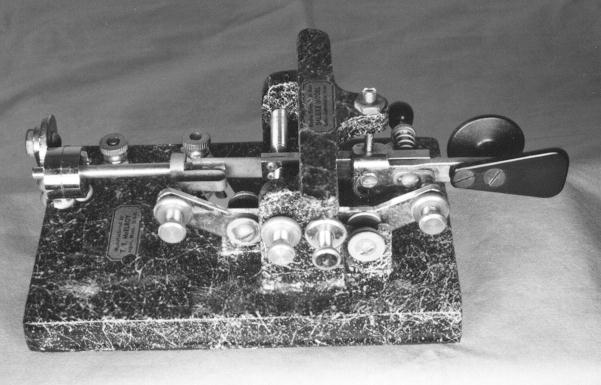
The McElroy 1940 Models 500 and 600:
These keys are similar to the 1939 models but have decals instead of name plates. The model 500 has a "Standard" finish, [281f] and the model 600 (Shown) has a "Deluxe Marbelite" finish. [281g](Tom French - W1IMQ photo.)
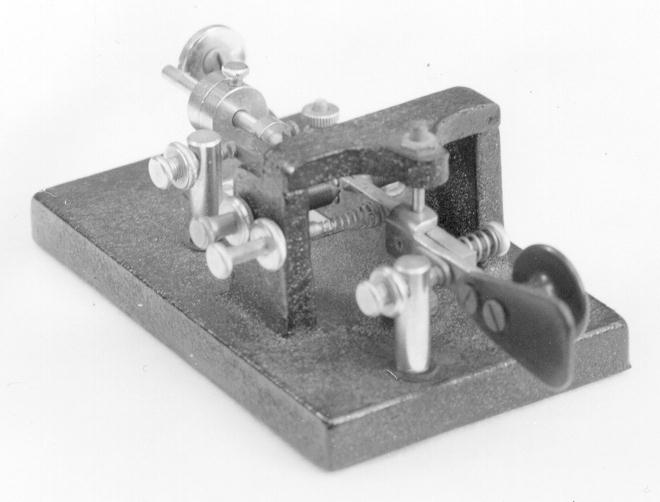
The McElroy 1941 Model A-400 "Amateur Model":
In a considerable departure from his previous bugs, McElroy designed this key without the "T" frame and with the more conventional Vibroplex-like vertical support posts for the dot and dash contacts. It was only available in the "Standard" finish. [281h]. (Tom French photograph.)
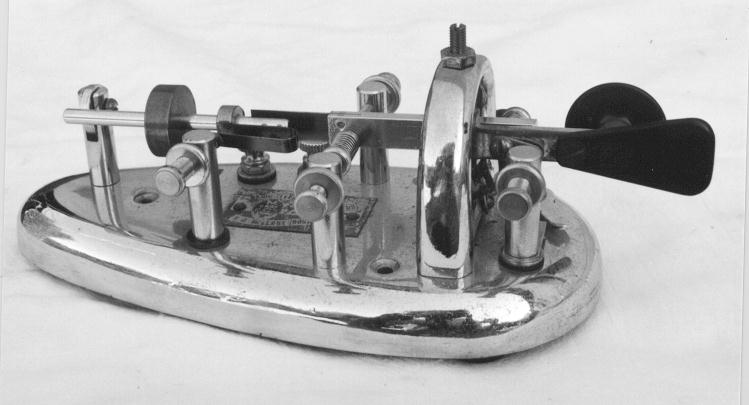
The McElroy Oval-Based S-600 Super Stream-Speed Bug: (1941 - 1942 )
This beautiful chrome-plated, oval-based bug is a must for any serious collector and, happily, there are quite a few of them around. [282] (Tom French photo.)
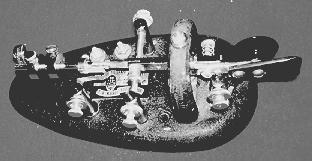
This rare All-Black wrinkle-finish version of the S-600 may be the only one manufactured. Unique keys such as this are hard to find and command high prices from collectors who specialize in McElroy keys. [282a]
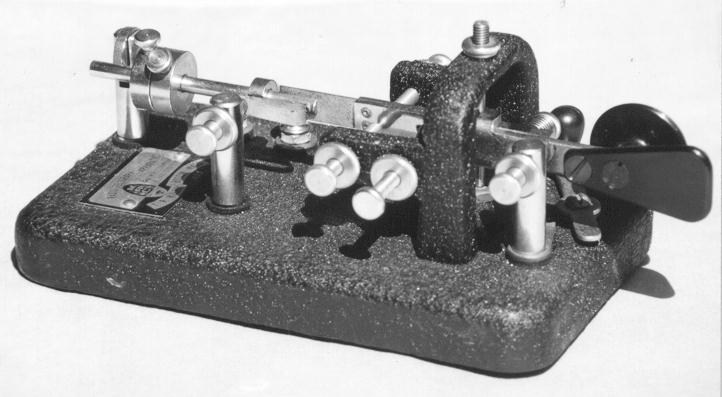
The McElroy P-500 Bug:
(1941 - 1942) This key has a massive All-Black wrinkle finished frame. [284a].

It was also made in Grey wrinkle finish. [284] (Tom French Photo.)
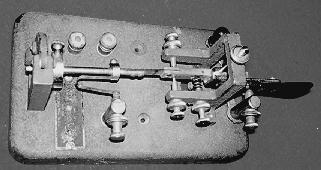
The McElroy CP-500 Bug: (1942)
The CP-500 looks like a Vibroplex Original because it has a rectangular rather than rounded frame. Black wrinkle finish [284b]. Grey wrinkle finish [284c].

McElroy Telegraph Apparatus Company (TAC) CP-510 / 810 Bugs: (1936-1938)
The Telegraph Apparatus Company (TAC) was one of Ted McElroy’s other companies. The labels on these keys read "Not Inc." to show that it was not incorporated. TAC keys are characterized by a frame with a large circular hole drilled through it for the lever.
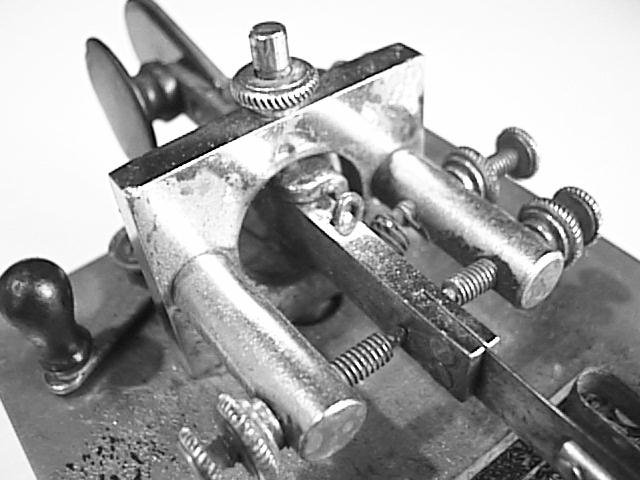
They are often called "Hole-in-the-Wall" bugs because of the circular hole. They are quite common. Model CP-810 (All-chromed): [286] Model CP-510 (Black base): [286a]
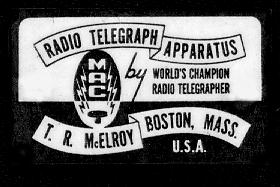
The McElroy Generic Label:
This label was used to identify many of
McElroy’s later keys and code practice oscillators.
This label may be printed ( filename: 7605.pcx or 7605.gif in the /w1tp
folder or in www.w1tp.com ) and copied onto aluminum and used
to make a reproduction/replacement label if yours is missing.
The vertical and horizontal dimensions must be adjusted to
1.00 X 1.75 inches to achieve the correct size.

The Electro Bug: ( 1930’s - )
The Electro Manufacturing Company made this interesting key in two models. The Junior is a conventional bug. [288] The one shown uses electric current from the keyed circuit to activate an electromagnet which causes the lever to vibrate. A switch selects various current taps to adjust for different keyed circuits. Nickel-Plated base: [288a]. Black base: [288b].

The Electric Specialty Co. Kit" Bug: ( 1939 - )
This is the only bug that was offered in kit form. Also called the "Cedar Rapids Bug", it was advertised as the "Radio Speed Bug" and sold primarily to radio operators for about $ 4.00. They are fairly common. [290]

The Melehan Valiant Full-Automatic Bug: ( 1939 - )
Mel Hansen (W6MFY) manufactured this rare and complex bug. Actually consisting of two bugs on the same base, it was capable of making dots AND dashes automatically. They are very hard to find! This one belongs to collector Russ Keinman - WA5Y. [292]
The Canadian Dow-Key Bugs: (1949 - 1950’s)
These bugs were built by Paul Dow of Winnipeg, Manitoba, Canada.

Rotating-Frame "Universal" Model :
This Dow Key bug had a frame which could be rotated to allow it to be used as a straight key or even a left-handed bug. [294]

The "Bent-Frame" Model.
This model had a frame which was permanently bent about 30 degrees to the right. The contacts were also bent to the right. It had a polished brass base and mechanism. [294a]
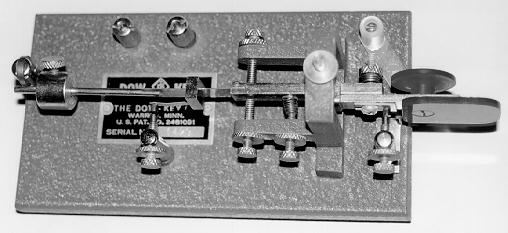
The Conventional Model. (Also called "Standard Model")
This model was very similar in design to the classic Vibroplex Original. [294b]

The British Eddystone Bug: (1948)
This unusual bug was manufactured on an oval base and has a cover which gives it a very distinctive look. The paddle is contoured and provides a very nice "feel."
It is widely believed that only 500 of these bugs were ever made but I have seen and owned so many of them that I believe this number may be on the low side. [295]
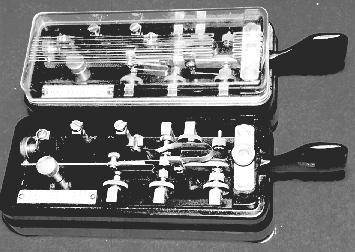
The Skillman Japanese Bugs: (Also called "Jelectro")( 1949 - )
Tens of thousands of these bugs were made by Swallow, Skilman, and Hi-Mound, imported into this country, and sold by Lafayette Radio, Radio Shack, and many other retailers. They were extremely inexpensive but have a nice crisp feel when properly adjusted. Very common. [296]

The Hills Vari-Speed attachment:
This device was sold by A. Hills of Dayton, Ohio. It was designed to allow the speed of a bug to be changed quickly while the operator was sending by simply swinging the weights forward or back. They are quite difficult to find and it is nice to have one in any bug collection. [297]

Left-Handed Bugs:
Left handed versions of most bugs turn up occasionally. Since very few were made, they generally double the value of a bug. This picture shows a left-handed Vibroplex Blue Racer Presentation Model. [298]
(A Hills Vari-Speed is shown mounted on the vibrating shaft.)